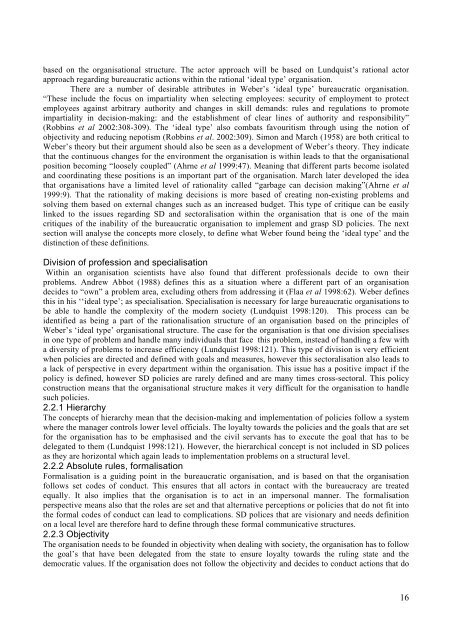From 'grey to green'- investigating the capabilities of the ... - lumes
From 'grey to green'- investigating the capabilities of the ... - lumes
From 'grey to green'- investigating the capabilities of the ... - lumes
You also want an ePaper? Increase the reach of your titles
YUMPU automatically turns print PDFs into web optimized ePapers that Google loves.
ased on <strong>the</strong> organisational structure. The ac<strong>to</strong>r approach will be based on Lundquist’s rational ac<strong>to</strong>rapproach regarding bureaucratic actions within <strong>the</strong> rational ‘ideal type’ organisation.There are a number <strong>of</strong> desirable attributes in Weber’s ‘ideal type’ bureaucratic organisation.“These include <strong>the</strong> focus on impartiality when selecting employees: security <strong>of</strong> employment <strong>to</strong> protectemployees against arbitrary authority and changes in skill demands: rules and regulations <strong>to</strong> promoteimpartiality in decision-making: and <strong>the</strong> establishment <strong>of</strong> clear lines <strong>of</strong> authority and responsibility”(Robbins et al 2002:308-309). The ‘ideal type’ also combats favouritism through using <strong>the</strong> notion <strong>of</strong>objectivity and reducing nepotism (Robbins et al. 2002:309). Simon and March (1958) are both critical <strong>to</strong>Weber’s <strong>the</strong>ory but <strong>the</strong>ir argument should also be seen as a development <strong>of</strong> Weber’s <strong>the</strong>ory. They indicatethat <strong>the</strong> continuous changes for <strong>the</strong> environment <strong>the</strong> organisation is within leads <strong>to</strong> that <strong>the</strong> organisationalposition becoming “loosely coupled” (Ahrne et al 1999:47). Meaning that different parts become isolatedand coordinating <strong>the</strong>se positions is an important part <strong>of</strong> <strong>the</strong> organisation. March later developed <strong>the</strong> ideathat organisations have a limited level <strong>of</strong> rationality called “garbage can decision making”(Ahrne et al1999:9). That <strong>the</strong> rationality <strong>of</strong> making decisions is more based <strong>of</strong> creating non-existing problems andsolving <strong>the</strong>m based on external changes such as an increased budget. This type <strong>of</strong> critique can be easilylinked <strong>to</strong> <strong>the</strong> issues regarding SD and sec<strong>to</strong>ralisation within <strong>the</strong> organisation that is one <strong>of</strong> <strong>the</strong> maincritiques <strong>of</strong> <strong>the</strong> inability <strong>of</strong> <strong>the</strong> bureaucratic organisation <strong>to</strong> implement and grasp SD policies. The nextsection will analyse <strong>the</strong> concepts more closely, <strong>to</strong> define what Weber found being <strong>the</strong> ‘ideal type’ and <strong>the</strong>distinction <strong>of</strong> <strong>the</strong>se definitions.Division <strong>of</strong> pr<strong>of</strong>ession and specialisationWithin an organisation scientists have also found that different pr<strong>of</strong>essionals decide <strong>to</strong> own <strong>the</strong>irproblems. Andrew Abbot (1988) defines this as a situation where a different part <strong>of</strong> an organisationdecides <strong>to</strong> “own” a problem area, excluding o<strong>the</strong>rs from addressing it (Flaa et al 1998:62). Weber definesthis in his ‘‘ideal type’; as specialisation. Specialisation is necessary for large bureaucratic organisations <strong>to</strong>be able <strong>to</strong> handle <strong>the</strong> complexity <strong>of</strong> <strong>the</strong> modern society (Lundquist 1998:120). This process can beidentified as being a part <strong>of</strong> <strong>the</strong> rationalisation structure <strong>of</strong> an organisation based on <strong>the</strong> principles <strong>of</strong>Weber’s ‘ideal type’ organisational structure. The case for <strong>the</strong> organisation is that one division specialisesin one type <strong>of</strong> problem and handle many individuals that face this problem, instead <strong>of</strong> handling a few witha diversity <strong>of</strong> problems <strong>to</strong> increase efficiency (Lundquist 1998:121). This type <strong>of</strong> division is very efficientwhen policies are directed and defined with goals and measures, however this sec<strong>to</strong>ralisation also leads <strong>to</strong>a lack <strong>of</strong> perspective in every department within <strong>the</strong> organisation. This issue has a positive impact if <strong>the</strong>policy is defined, however SD policies are rarely defined and are many times cross-sec<strong>to</strong>ral. This policyconstruction means that <strong>the</strong> organisational structure makes it very difficult for <strong>the</strong> organisation <strong>to</strong> handlesuch policies.2.2.1 HierarchyThe concepts <strong>of</strong> hierarchy mean that <strong>the</strong> decision-making and implementation <strong>of</strong> policies follow a systemwhere <strong>the</strong> manager controls lower level <strong>of</strong>ficials. The loyalty <strong>to</strong>wards <strong>the</strong> policies and <strong>the</strong> goals that are setfor <strong>the</strong> organisation has <strong>to</strong> be emphasised and <strong>the</strong> civil servants has <strong>to</strong> execute <strong>the</strong> goal that has <strong>to</strong> bedelegated <strong>to</strong> <strong>the</strong>m (Lundquist 1998:121). However, <strong>the</strong> hierarchical concept is not included in SD policesas <strong>the</strong>y are horizontal which again leads <strong>to</strong> implementation problems on a structural level.2.2.2 Absolute rules, formalisationFormalisation is a guiding point in <strong>the</strong> bureaucratic organisation, and is based on that <strong>the</strong> organisationfollows set codes <strong>of</strong> conduct. This ensures that all ac<strong>to</strong>rs in contact with <strong>the</strong> bureaucracy are treatedequally. It also implies that <strong>the</strong> organisation is <strong>to</strong> act in an impersonal manner. The formalisationperspective means also that <strong>the</strong> roles are set and that alternative perceptions or policies that do not fit in<strong>to</strong><strong>the</strong> formal codes <strong>of</strong> conduct can lead <strong>to</strong> complications. SD polices that are visionary and needs definitionon a local level are <strong>the</strong>refore hard <strong>to</strong> define through <strong>the</strong>se formal communicative structures.2.2.3 ObjectivityThe organisation needs <strong>to</strong> be founded in objectivity when dealing with society, <strong>the</strong> organisation has <strong>to</strong> follow<strong>the</strong> goal’s that have been delegated from <strong>the</strong> state <strong>to</strong> ensure loyalty <strong>to</strong>wards <strong>the</strong> ruling state and <strong>the</strong>democratic values. If <strong>the</strong> organisation does not follow <strong>the</strong> objectivity and decides <strong>to</strong> conduct actions that do16
















